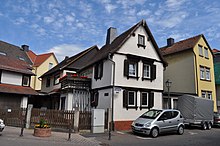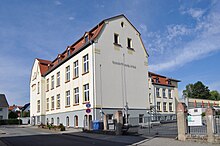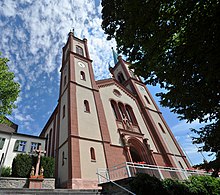Kirdorf
|
Kirdorf
City of Bad Homburg vor der Höhe
|
|
|---|---|
| Coordinates: 50 ° 14 ′ 29 ″ N , 8 ° 36 ′ 38 ″ E | |
| Height : | 195 m above sea level NN |
| Incorporation : | June 29, 1901 |
| Postal code : | 61350 |
| Area code : | 06172 |
Kirdorf is a district in the north of the city of Bad Homburg vor der Höhe in the Hochtaunuskreis in Hesse , northwest of Frankfurt am Main . The district lies within the district of Bad Homburg.
history
The historic mark on the Kirdorfer district date back to the Celtic era : Even today, tumuli in the Hardt forest preserve. A cremation grave was found from Roman times ; a villa rustica is presumed, but has not yet been proven archaeologically. There is also little evidence of an early Franconian foundation, because Franconian row graves have not been found, nor is the name of the village in any way related to the Franconian conquest . Even the traditional field name "Hostatt" most likely does not refer to a noble "Hofstatt", but to a "Hochstatt" in the former marshland of the Kirdorfer Bach, which is now canalized.
The place name, which goes back to the Franks, comes from Kirchdorf. It can be assumed that the Franks called a church village of importance in each of their districts "Kirchdorf". The current district of Bad Homburg probably had this function in Niddagau. The foundation walls of a Romanesque church were found on the Rabenstein in the 19th century . In the course of time, the place name changed into its current form.
The first written mention of the "villa Kirchdorph" in Niddagau comes from the year 892 and is in the Lorsch Codex . According to her, Alolf and Huda gave their property there on November 17, 892, together with 58 servants to the Benedictine monastery Lorsch on Bergstrasse . The name of the village and the location of the church at the highest point in the middle of the village give rise to the assumption that the settlement had long existed around a pagan sanctuary, which was then replaced by a Christian church - a common practice at the time of expansion of Christianity in the Franconian Empire and in this case combined with a renaming of the place, which has now been emphasized by the church. However, this conclusion has not yet been confirmed objectively either.
In the course of its further history, Kirdorf was repeatedly subordinate to the Archdiocese of Mainz, but became temporarily Lutheran during the Reformation under the rule of the Counts of Stolberg.
During the Thirty Years' War , the troops of Duke Christian von Braunschweig-Wolfenbüttel burned the place, which had now become Catholic again, on June 7, 1622. Only one house survived this fire unscathed. Since the predominantly Protestant-Calvinist Landgraviate of Hessen-Homburg was founded in the same year , Kirdorf soon looked like a Catholic island in a Protestant environment. This had a lasting impact on the population. In the Reichsdeputationshauptschluss of 1803, Kirdorf was first assigned to the princes of Nassau-Usingen , but then became part of the Landgraviate itself through an exchange.
The Catholic parish belonged to the Archdiocese of Mainz from 1232 to 1803 and was only temporarily (from 1540 to 1606) Lutheran through the conversion of the Stolbergers (as already mentioned above). From 1803 to 1821 she came to the Vicariate General Aschaffenburg and was then directly subordinate to the Pope in Rome until 1836 . After that she belonged to the new diocese of Mainz , whereby there was always a good relationship between the Kirdorfern and Bishop Ketteler . He also consecrated the mighty St. Johanneskirche in 1862 , which - as the largest church building in the Vordertaunus - received the popular name Taunusdom . The church was built in a modification of the Byzantine style by the architect and master builder of the Mainz cathedral, Ignaz Opfermann (1799–1866). The organ (main work) was made by the master organ builder Hermann Dreymann from Mainz . - The parish has been part of the Limburg diocese since 1884 .
In 1849 the first mayor was elected, Johannes Raab .
For centuries, the Kirdorf population lived from agriculture combined with linen weaving. In 1820 the healing springs were rediscovered in Homburg ; A flourishing health resort quickly developed there. The Kirdorfer recognized their opportunity and learned the trades that were needed in the up-and-coming neighboring town: Most of the bricklayers, carpenters and joiners from Kirdorf, the traders, farmers and day laborers, laundresses, coachmen, maids and postmen owed their income to the health resort from Homburg. In 1854, the Prussian garden architect Peter Joseph Lenné laid out the first part of the Homburg spa gardens on Kirdorfer and Gonzenheimer meadows and fields . In 1876 an extensive grass tennis court was created, the first tennis court on the continent. In 1890 they played on hard courts made of ground red slag, which quickly became the standard of modern tennis courts.
In the 19th and early 20th centuries, the people of Kirdorf founded many associations , most of which are still active today. In general, the Kirdorf club life is one of the most active in the city.
In 1866 the last Landgrave of Hessen-Homburg died. The Landgraviate (with Kirdorf) first fell to Hessen-Darmstadt and a few months later after the war of 1866 to Prussia .
After the founding of the empire there were violent differences of opinion during the culture war between the liberal Homburg and the Catholic Kirdorf. Notwithstanding this, the Kirdorfer built a sister house from 1873, which was inaugurated on June 24, 1874 by Bishop Ketteler .
After lengthy negotiations and fierce resistance, the rural community of Kirdorf was incorporated into Bad Homburg vor der Höhe in 1902. The incorporation contract brought the Kirdorf population a number of amenities, but also the loss of independence, which led to resistance decades later. Achievements include the exterior plastering of St. John's Church, carried out in 1906, the maintenance obligation for the church building, the rectory and the nurses 'house as well as the Citizens' School II and IV, which opened in 1910, today's Ketteler-Francke-School, which replaced the old school . 1914 Kirdorf was coupled to the electrical power grid connected. In 1911, a Protestant service was held in Kirdorf for the first time. In 1913 the Protestant Memorial Church is ceremonially inaugurated.
During the Second World War , the town center and the Kirdorf district were largely spared, but on August 24 and 25, 1942, incendiary bombs were dropped on the town. Although there was only one civilian casualty caused by low-flying aircraft, almost 200 young men from Kirdorf lost their lives as soldiers in the war. This ended for the Kirdorf civilian population on Good Friday, March 30, 1945, when US troops marched in. After that, Kirdorf belonged to the American zone of occupation . The US military administration set up a small DP camp in the town to accommodate so-called displaced persons , the majority of whom were former slave laborers from the Soviet Union . The camp existed beyond the establishment of the Federal Republic until the mid-1950s.
A previously unknown construction activity led to the development of large parts of the fertile Kirdorfer Feldmarkung in the following decades. In the Hardtwald a villa area was formed, which is counted among the preferred residential areas in the Rhine-Main area. Only a small part of the field and meadow marking remained undeveloped. The area known nationwide as Kirdorfer Feld was almost completely designated as a landscape protection area and nature reserve in 1999 (see below); there is also an apple tree museum .
Churches
Taunus Cathedral

The St. John's Church in Kirdorfer is often referred to as the Taunus Cathedral. The architect and master builder of the Mainz cathedral, Ignaz Opfermann (1799–1866), built the church between 1858 and 1862 in the late classicistic arched style. The two towers that led to the designation as the cathedral are striking .
Inside there is an Art Nouveau painting that was created from 1923 to 1925 by the Güntersleben church painter Augustin Kolb (1869–1942) and his three sons. The baptismal font dates from 1661. The main altar was made in 1879/80 as a winged altar by the sculptors Jakob Busch (1860–1916) and Karl Kreis (1861–1882) from Hanau-Steinheim . The pulpit from 1862 is decorated with five gilded wood-carved reliefs from 1925 by Alban Kolb .
The organ by the Mainz master organ builder Hermann Dreymann has been a listed building since 1974 as the largest and only well-preserved organ in the Limburg diocese.
Evangelical Memorial Church
- Coordinate: 50 ° 14 ′ 16.4 ″ N , 8 ° 36 ′ 28.9 ″ E
At the latest with the incorporation of the Catholic Kirdorf into the Protestant Bad Homburg in 1902, the number of Protestants in Kirdorf rose, so that the need for a Protestant church arose. With the help of a foundation by the Bad Homburg couple Dippel, the Protestant Memorial Church was built and inaugurated in 1913.
Pulpit, altar, chandelier and the baptismal font in the baptistery are a gift from Kaiser Wilhelm II. They come from the Bad Homburg Castle Church, where they were no longer needed after the building of the Erlöserkirche .
The organ made by Kern (Strasbourg) dates from 1988. In 2002 the interior was restored. Particularly noticeable are the stained glass windows, especially the rose window above the altar. In this window, Christ is shown in bright colors at the Sermon on the Mount.
leisure
There are a large number of associations in Kirdorf . With the Bürgerhaus Kirdorf, they are offered an event location next to their own club houses. Sports clubs have a Wiesenborn soccer field and the Northwest sports center , which also has a miniature golf course .
The local history has been presented in the Kirdorfer Heimatmuseum Am Kirchberg 41 (right next to the Taunus Cathedral ) since 2006 .
nature
In the north-west of Kirdorf is the Kirdorfer Feld , an area of around 160 hectares of orchards , around 60 hectares of which are under nature protection . A special feature is the abundant population of otherwise very rare and particularly worthy of protection orchids , in particular the broad-leaved orchids .
See also
Web links
- The place on the Bad Homburg website
- Kirdorf, Hochtaunuskreis. Historical local dictionary for Hessen. In: Landesgeschichtliches Informationssystem Hessen (LAGIS).
- Literature about Kirdorf in the Hessian Bibliography
Individual evidence
- ^ Lotz, Friedrich, History of the City of Bad Homburg vor der Höhe, Volume I (2nd edition Frankfurt am Main 1977), p. 231.
- ↑ Colloquium Stefan Ohmeis / Rüdiger Kurth / Alexander Wächterhäuser January 16, 2010.
- ↑ Church leader Hochtaunus ( Online p. 16/17. ( Memento of the original from September 24, 2015 in the Internet Archive ) Info: The archive link has been inserted automatically and has not yet been checked. Please check the original and archive link according to the instructions and then remove this notice. ; PDF; 4.8 MB, accessed on January 14, 2016)
- ↑ Church guide Hochtaunus ( Online p. 6/7. ( Memento of the original from September 24, 2015 in the Internet Archive ) Info: The archive link has been inserted automatically and has not yet been checked. Please check the original and archive link according to the instructions and then remove this notice. ; PDF; 4.8 MB, accessed on January 14, 2016)






